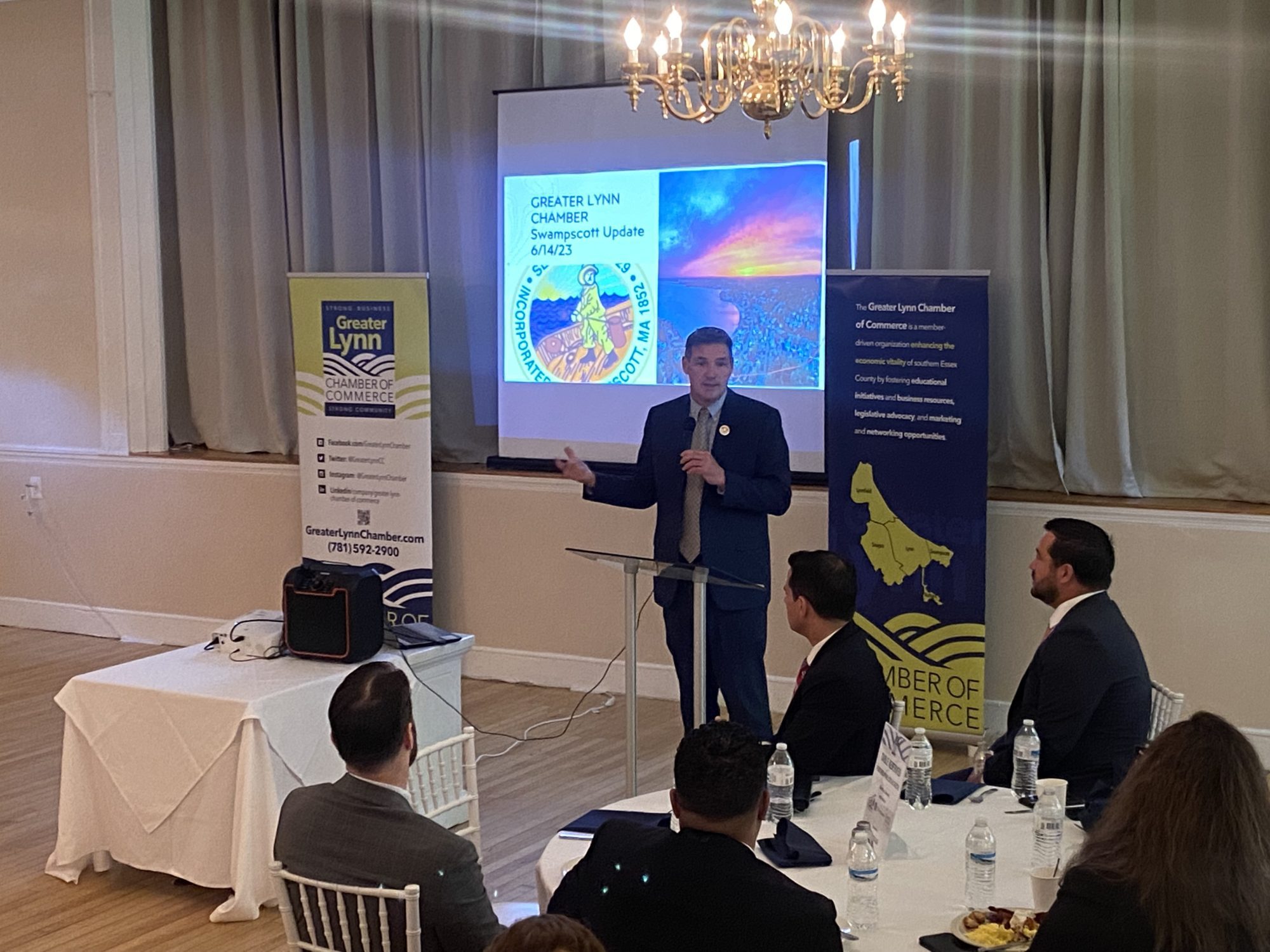NAHANT — Local officials from Nahant, Lynn, and Swampscott gathered at the Nahant Country Club Wednesday morning to share their municipalities’ achievements and goals at the Greater Lynn Chamber of Commerce State of the Region breakfast.
Lynn Mayor Jared Nicholson, Nahant Town Administrator Tony Barletta, and Swampscott Town Administrator Sean Fitzgerald discussed unique challenges and objectives for their communities, including waterfront development in Lynn and Swampscott, and mitigating flood risks in Nahant.
As business owners and government officials finished their breakfasts and coffees, Economic Development and Industrial Corporation Executive Director Jim Cowdell presented Lynn’s most recent strides toward economic development. He introduced his presentation by acknowledging that Lynn is currently in a “historic time” for business growth.
Cowdell spoke about a number of ongoing developments in Lynn such as the 811 Lynnway development, where a luxury condominium will be built at the site of a used-car lot, which he referred to as a “home run” for the city. He also mentioned the city’s Harbor Park project, in which a landfill site near the Lynnway will be converted into a 33-acre park.
“That will be a Harbor Park that, really, folks from all over the area will enjoy,” Cowdell said. “These are places where people can live, learn, work, and enjoy the city.”
Before Nicholson made his way on stage, Cowdell recognized one of the city’s recent accomplishments — bringing back the long-awaited MBTA ferry expected to set sail June 26. Cowdell acknowledged former Mayor Thomas McGee, who he said suggested the ferry nearly 17 years ago.
“It really opens everything up for us,” Cowdell said. “This has been a goal of ours for almost 20 years.”
Nicholson reviewed the city’s work toward addressing a goal outlined in its Vision Lynn survey — forging a safe, diverse, and affordable city. He cited the near $35 million in American Rescue Act funding dedicated toward park renovations in the city, efforts to construct a temporary MBTA train platform, and the city’s goal of expanding its Pre-Kindergarten programs.
“There are just too many students that do not have access to preschool education,” Nicholson said. “That’s been a real effort for us to try to act on this past year, and Lynn Public Schools is adding 115 seats next school year for pre-K.”
Barletta discussed climate-change preparedness, Nahant’s restrictions for financial growth, and its infrastructure projects.
In the last few years, Barletta said the town passed the Wetlands Protection and Stormwater Bylaws to ensure residents don’t pollute water, obstruct municipal drainage, or negatively impact the town’s natural resources.
Still, Barletta said, the town aims to improve its coastal infrastructure to guard against future flooding. After a 2018 storm left $2.4 million in damage, Barletta said the town is seeking Federal Emergency Management Agency funding to repair and renovate its coastal barriers.
“We need to build it bigger, stronger, so that we don’t fall into that situation again,” Barletta said. “It’s local bylaws, it’s prevention of flooding, it’s improvement of daily stormwater systems, and it’s determining how quickly we can recover.”
Discussing infrastructure, Barletta promised the crowd that after six years, the town is finishing up its sewer-pipeline replacement project on the Lynnway.
“After this week, we will not be responsible for any traffic on the Lynnway,” Barletta joked.
Barletta commented on other infrastructure goals such as creating affordable-housing units to align with the town’s Housing Production Plan and spending $125,000 on a new public-safety building.
Receiving little-to-no commercial tax revenue, Barletta said the town saves most of its revenue from property taxes capped at 2.5% growth annually.
“80% to 90% of our budget comes from real-estate taxes, which is capped at 2.5% growth each year, so we’re constantly trying to spread the dollar as far as we can utilize grants and be creative with how we try to attack these different challenges,” Barletta said.
Swampscott Town Administrator Sean Fitzgerald opened his presentation by addressing the town’s work to promote diversity, before diving into its efforts to raise its bond rating and build its stabilization funds.
He cited the town’s ability to build a new $100 million elementary school as a sign of financial stability and balance, and presented the town’s gradual tax-rate decline for single-family households.
“We were the third-highest average single-family tax bill in 2013,” Fitzgerald said. “We’re now 8.1% higher than average out of the 34 states reported.”
Fitzgerald also mentioned a number of Swampscott’s development projects, such as the Hadley School hotel construction and the town’s purchase of the Hawthorne by the Sea property on Humphrey Street for a public-park space.
“Buying that property was inconceivable seven years ago. We couldn’t even build an elementary school. Now, it’s wrapped into the master plan. We’re on point, and it takes a lot of focus to stay on point,” Fitzgerald said. “Big picture — we’re looking at the future.”

